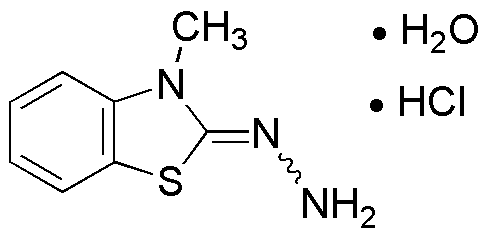3-Methyl-2-benzothiazolinone hydrazone hydrochloride monohydrate is widely utilized in research focused on:
- Analytical Chemistry: This compound serves as a reagent for the detection of various metal ions, making it valuable in environmental monitoring and quality control in laboratories.
- Pharmaceutical Development: It is used in the synthesis of pharmaceutical intermediates, aiding in the development of new drugs with potential therapeutic effects.
- Biochemical Research: The compound is employed in studies related to enzyme inhibition, providing insights into metabolic pathways and potential drug targets.
- Material Science: It can be utilized in the formulation of polymers and coatings, enhancing the properties of materials used in various industrial applications.
- Food Industry: This chemical is also explored for its potential as a preservative, helping to extend the shelf life of food products while maintaining safety and quality.
General Information
Properties
Safety and Regulations
Applications
3-Methyl-2-benzothiazolinone hydrazone hydrochloride monohydrate is widely utilized in research focused on:
- Analytical Chemistry: This compound serves as a reagent for the detection of various metal ions, making it valuable in environmental monitoring and quality control in laboratories.
- Pharmaceutical Development: It is used in the synthesis of pharmaceutical intermediates, aiding in the development of new drugs with potential therapeutic effects.
- Biochemical Research: The compound is employed in studies related to enzyme inhibition, providing insights into metabolic pathways and potential drug targets.
- Material Science: It can be utilized in the formulation of polymers and coatings, enhancing the properties of materials used in various industrial applications.
- Food Industry: This chemical is also explored for its potential as a preservative, helping to extend the shelf life of food products while maintaining safety and quality.
Documents
Safety Data Sheets (SDS)
The SDS provides comprehensive safety information on handling, storage, and disposal of the product.
Product Specification (PS)
The PS provides a comprehensive breakdown of the product’s properties, including chemical composition, physical state, purity, and storage requirements. It also details acceptable quality ranges and the product's intended applications.
Certificates of Analysis (COA)
Search for Certificates of Analysis (COA) by entering the products Lot Number. Lot and Batch Numbers can be found on a product’s label following the words ‘Lot’ or ‘Batch’.
*Catalog Number
*Lot Number
Certificates Of Origin (COO)
This COO confirms the country where the product was manufactured, and also details the materials and components used in it and whether it is derived from natural, synthetic, or other specific sources. This certificate may be required for customs, trade, and regulatory compliance.
*Catalog Number
*Lot Number
Safety Data Sheets (SDS)
The SDS provides comprehensive safety information on handling, storage, and disposal of the product.
DownloadProduct Specification (PS)
The PS provides a comprehensive breakdown of the product’s properties, including chemical composition, physical state, purity, and storage requirements. It also details acceptable quality ranges and the product's intended applications.
DownloadCertificates of Analysis (COA)
Search for Certificates of Analysis (COA) by entering the products Lot Number. Lot and Batch Numbers can be found on a product’s label following the words ‘Lot’ or ‘Batch’.
*Catalog Number
*Lot Number
Certificates Of Origin (COO)
This COO confirms the country where the product was manufactured, and also details the materials and components used in it and whether it is derived from natural, synthetic, or other specific sources. This certificate may be required for customs, trade, and regulatory compliance.


